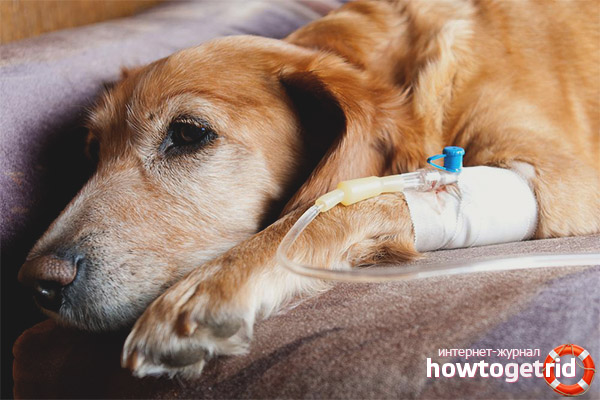The content of the article
Plague - a viral disease that is deadly. It is expressed in fever, dysfunction of the gastrointestinal tract, respiratory organs, damage to the skin and mucous membranes. Often leads to severe forms of encephalitis or meningitis.
The disease has been known to dog breeders since the time when dogs were domesticated. Even in the scientific works of Aristotle, the plague was described as a sore throat. On the territory of Russia, for the first time, the disease manifested itself in Crimea, it happened in 1762, which formed the basis of the name “Crimean disease”. At the very beginning of the twentieth century, a scientist from France Carré confirmed that the disease is viral in nature.
Factors of occurrence and features of the virus
The causative agent of the disease is a virus belonging to the vast family of paramyxoviruses. Once in the environment, the plague pathogen virus loses its stability. Its activity is lost after a week or a little more when it is in the feces or mucus from the nose of animals.
Being chilled or drained, the virus can remain active for several months. For more than a year, function persists when the virus is lyophilized. At 100 degrees Celsius, the virus instantly breaks down, and only half an hour is required for the breakdown of the virus, if it is heated to 60 degrees.
Environmental factors and substances for disinfection can quickly deactivate the pathogen: UV rays and a one percent solution of lysol in half an hour, light from the sun or formalin solution within two to three hours, in an hour the virus “dies” from exposure to a two percent solution of caustic soda.
In the form of an epidemic in various animals, the disease is present all over the world. Arctic foxes, wolves, bears, Ussuri raccoons, foxes and weasels are highly susceptible to the virus.
Antibodies received by a born-born individual from the mother, which are in milk, can form passive immunity in puppies, no more than two weeks old. But this does not happen in every case. In animals that have successfully survived the plague, immunity is fixed for a long time, but does not have sterility and is not always acquired for the entire period of life.
Fact! Even animals that have been immunized can lose their resistance to the causative agent of the disease, enduring prolonged stress, contact with an animal with an open disease or immunosuppression.
In most cases, generalized plague is observed in dogs that have not been vaccinated. In particular, this is true for puppies aged 8-16 weeks if their colostral immunity obtained with maternal colostrum is impaired.
Dogs of short muzzle breeds suffer from plague less often in comparison with long muzzle breeds. In its various forms, almost every dog suffers from a plague, but usually it happens at a young age.
Routes of transmission and infection
The main factors determining the transmission of the pathogen between animals are hygiene items and their care, infected, clothing, blood-sucking insects, birds, food and rodents.In addition, the latter can not only transport the virus mechanically, but also secrete it into the environment without any symptoms of the disease.
The reservoir of the virus in nature is homeless dogs or wild animals. The disease can occur in any season, expressed as an epidemic or sporadically.
Manifestations of the disease
The incubation period (lasting from the moment when the pathogen entered the body of the animal until the first signs of the disease is manifested) in dogs can last from 3 to 21 days. In some cases, the incubation period is much longer, it can take 2-3 months. In recent years, given how the immune system of animals develops, the clinical picture of the disease has undergone certain changes.
If earlier the disease was expressed clearly and clinically, accompanied by a significant increase in body temperature and symptoms of intoxication, now an atypical form of the disease or a combination of the disease with other infections is increasingly observed.
At the first stages (three to five days), the disease is expressed in conjunctivitis - bilateral, serous. In the morning and afternoon, the eyelashes of the animal are glued together with purulent discharge of various colors, the dog opens his eyes hard, experiences photophobia. A pet can strive to leave brightly lit rooms, find a shadow, hide under bed, tables, look for cool areas. In combination with conjunctivitis, or somewhat later, profuse rhinophea appears, a dry cough that transforms into wet during the week. Nasal discharge is cloudy, transparent or green.
Types and course of the disease
The severity of the manifestations of the disease determines the conditional division of the plague into several forms: generalized, intestinal, nervous, skin or pulmonary.
How a particular form of the disease will develop is primarily due to how reactive the canine organism is. Various clinical manifestations (from fever to symptoms of damage to the nervous system) can be caused by the same strain of the pathogen virus.
The course of the disease can be acute and subacute, fulminant or chronic. Also, there is an abortive form of the disease.
- The fulminant course of the disease implies an almost complete absence of the manifestations of the disease, the animal dies within 24 hours.
- The acute course is accompanied by a rapid increase in temperature up to 41 degrees, this symptom is most pronounced in the evening hours or at night. The appetite of the animal can be perverted, but in most cases it disappears. The dog is very thirsty. After coma develops, the puppy or adult will die on the twenty-seventh day of illness.
- The subacute course is expressed in a significant increase in body temperature, which is fixed for a period from 1 day to 14 days. Subsequently, the fever becomes moderate. In puppies whose age has reached one and a half months, the temperature may increase slightly or remain normal. Fever is accompanied by apathy, lethargic behavior, tremors, fear, lack of appetite, the nose is dry and rough.
- Pulmonary form. It is expressed in violation of the functions of the respiratory system: first, the upper respiratory tract is affected, then the lower ones. There is a sequence in the development of symptoms - from rhinitis to pneumonia and bronchitis.
- Intestinal form. It is accompanied by severe violations of the gastrointestinal tract, manifested by acute gastroenteritis, loss of appetite, diarrhea or constipation, nausea and vomiting. This can result in rapid dehydration and exhaustion of the pet. The stool contains a large amount of mucus, sometimes blood is mixed with it.
- The most serious and dangerous form for dogs is a plague of a nervous nature. In this situation, the forecast almost always becomes disappointing.This form threatens deadly complications: meningitis, epilepsy, paralysis, encephalitis and myelitis. This occurs as a result of the introduction of the pathogen into the cells of the brain and meninges. The clinical picture of complications appears 2-5 weeks after infection.
- Generalized form. It is the most common: about 90 percent of all diseases of animals by the plague are in it. It combines the manifestations of all the above forms of the disease.
Skin and nervous forms often proceed chronically. Plague-affected animals may experience muscle cramps, paralysis, loss of vision and hearing, ocular pupil overgrowth, or epilepsy, which are fixed for a long period, often throughout life.
Diagnosis of plague in dogs
The diagnosis is made by a specialist on the basis of an anamnesis, changes in the pathoanatomical plan, results of analyzes, clinical manifestations. A veterinarian will consider the following parameters:
- damage to the respiratory system;
- inflammatory processes in the gastrointestinal mucosa;
- the presence of flow from the nose and eyes;
- hyperkeratosis of the skin, nose, pillows of the feet and fingers.
Damage to the central nervous system, accompanied by tremors, epilepsy, paralysis and impaired functioning of the brain.
If the animal has 4-5 described manifestations, then we can safely assume a plague. Two of the five signs make it possible to suspect the presence of a disease, and three already make a diagnosis.
Disease therapy
It is important that assistance is provided to the animal in a timely manner, therapy should be comprehensive. If the owner is suspicious, the most appropriate way is to call the veterinarian to the apartment.
Therapy includes:
- Specific treatment (based on the use of immunoglobulins).
- The use of stimulants and modulators of immunity.
- Symptomatic treatment: antibiotics are used that suppress the pathological microflora.
- Antiallergic, vitamin, astringent or cardiac drugs.
- Drugs that stimulate the functioning of the central nervous system, anticonvulsants.
The dog should be kept in a warm, light-free, clean and isolated room, in which the air is moderately humid. The animal should be kept calm and quiet.
Also, a certain diet is prescribed, which is based on the age and breed of the dog.
Disease prevention
For vaccination in the territory of the Russian Federation, domestic preparations are used. Also nowadays, the use of imported vaccines is increasingly common. Injections are used to specifically prevent infection.
Puppies should be vaccinated, starting from the age of 2-3 months, injections are made up to two times during the year. Then, after a year, the animal is vaccinated once a year. After vaccination, it is forbidden to walk the animal, it is placed in a two-week quarantine. Before vaccinating a pet, you should rid it of helminths.
If the animal is sick, disinfection should be carried out in the rooms where it stayed.
Remember! If your pet is sick, you should first contact a veterinarian. Any independent actions of the owner may result in harm to the dog, which in some situations is fraught with its death.
Video: how to prevent a dog from dying from a plague











Submit